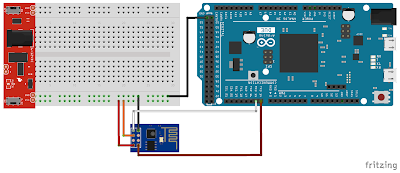The ESP8266 set in CWMODE=2, its IP should be 192.168.4.1 by default.
Note: It have problem if client side sent command too fast, in connection close and connect too close.
Connection:
Due8266WebControlLed_AP.ino
/*
Arduino Due - ESP 8266 WiFi Module
Act as AP mode, CWMODE=2
Serial (Tx/Rx) communicate to PC via USB
Serial3 (Tx3/Rx3) connect to ESP8266
Tx3 - ESP8266 Rx
Rx3 - ESP8266 Tx
ESP8266 CH_PD Connect to ESP8266 VCC
for firmware:
"v0.9.5.2 AT Firmware"
(http://goo.gl/oRdG3s)
AT version:0.21.0.0
SDK version:0.9.5
*/
#define ESP8266 Serial3
int LED = 13;
boolean FAIL_8266 = false;
#define BUFFER_SIZE 128
char buffer[BUFFER_SIZE];
void setup() {
pinMode(LED, OUTPUT);
digitalWrite(LED, LOW);
delay(300);
digitalWrite(LED, HIGH);
delay(200);
digitalWrite(LED, LOW);
delay(300);
digitalWrite(LED, HIGH);
delay(200);
digitalWrite(LED, LOW);
delay(300);
digitalWrite(LED, HIGH);
delay(200);
digitalWrite(LED, LOW);
do{
Serial.begin(115200);
ESP8266.begin(115200);
//Wait Serial Monitor to start
while(!Serial);
Serial.println("--- Start ---");
ESP8266.println("AT+RST");
delay(1000);
if(ESP8266.find("ready"))
{
Serial.println("Module is ready");
ESP8266.println("AT+CWMODE=2");
delay(1000);
clearESP8266SerialBuffer();
//Get and display my IP
sendESP8266Cmdln("AT+CIFSR", 1000);
//Set multi connections
sendESP8266Cmdln("AT+CIPMUX=1", 1000);
//Setup web server on port 80
sendESP8266Cmdln("AT+CIPSERVER=1,80",1000);
Serial.println("Server setup finish");
FAIL_8266 = false;
}else{
Serial.println("Module have no response.");
delay(500);
FAIL_8266 = true;
}
}while(FAIL_8266);
digitalWrite(LED, HIGH);
ESP8266.setTimeout(1000);
}
void loop(){
if(ESP8266.available()) // check if the esp is sending a message
{
Serial.println("Something received");
delay(1000);
if(ESP8266.find("+IPD,"))
{
String action;
Serial.println("+IPD, found");
int connectionId = ESP8266.read()-48;
Serial.println("connectionId: " + String(connectionId));
ESP8266.find("led=");
char s = ESP8266.read();
if(s=='0'){
action = "led=0";
digitalWrite(LED, LOW);
}else if(s=='1'){
action = "led=1";
digitalWrite(LED, HIGH);
}else{
action = "led=?";
}
Serial.println(action);
sendHTTPResponse(connectionId, action);
//Close TCP/UDP
//String cmdCIPCLOSE = "AT+CIPCLOSE=";
//cmdCIPCLOSE += connectionId;
//sendESP8266Cmdln(cmdCIPCLOSE, 1000);
}
}
}
void sendHTTPResponse(int id, String content)
{
String response;
response = "HTTP/1.1 200 OK\r\n";
response += "Content-Type: text/html; charset=UTF-8\r\n";
response += "Content-Length: ";
response += content.length();
response += "\r\n";
response +="Connection: close\r\n\r\n";
response += content;
String cmd = "AT+CIPSEND=";
cmd += id;
cmd += ",";
cmd += response.length();
Serial.println("--- AT+CIPSEND ---");
sendESP8266Cmdln(cmd, 1000);
Serial.println("--- data ---");
sendESP8266Data(response, 1000);
}
boolean waitOKfromESP8266(int timeout)
{
do{
Serial.println("wait OK...");
delay(1000);
if(ESP8266.find("OK"))
{
return true;
}
}while((timeout--)>0);
return false;
}
//Send command to ESP8266, assume OK, no error check
//wait some time and display respond
void sendESP8266Cmdln(String cmd, int waitTime)
{
ESP8266.println(cmd);
delay(waitTime);
clearESP8266SerialBuffer();
}
//Basically same as sendESP8266Cmdln()
//But call ESP8266.print() instead of call ESP8266.println()
void sendESP8266Data(String data, int waitTime)
{
ESP8266.print(data);
delay(waitTime);
clearESP8266SerialBuffer();
}
//Clear and display Serial Buffer for ESP8266
void clearESP8266SerialBuffer()
{
Serial.println("= clearESP8266SerialBuffer() =");
while (ESP8266.available() > 0) {
char a = ESP8266.read();
Serial.write(a);
}
Serial.println("==============================");
}
Related:
- Standalone ESP8266/ESP-12 (without controller/Arduino): web control on-board LED






























